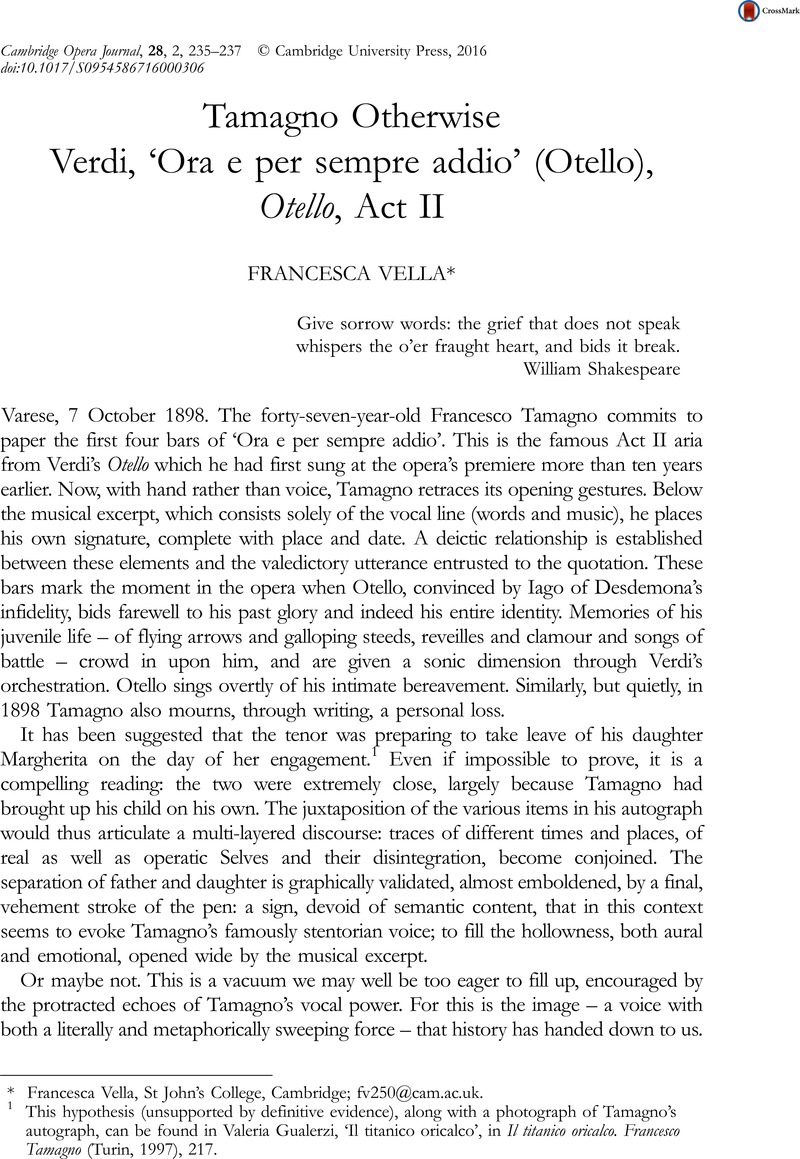No CrossRef data available.
Published online by Cambridge University Press: 28 September 2016

Francesca Vella, St John’s College, Cambridge; fv250@cam.ac.uk.
1 This hypothesis (unsupported by definitive evidence), along with a photograph of Tamagno’s autograph, can be found in Gualerzi, Valeria, ‘Il titanico oricalco’, in Il titanico oricalco. Francesco Tamagno (Turin, 1997), 217 Google Scholar.
2 See Piovano, Ugo, ‘Otello fu’. La vera vita di Francesco Tamagno il ‘tenore-cannone’ (Milan, 2005), 475–500 Google Scholar.
3 The epithet appears in Tegani, Ulderico, Cantanti di una volta (Milan, 1945)Google Scholar, and has more recently been borrowed by Piovano. The trope had nevertheless been established since the late nineteenth century.
4 See, for instance, Sterne, Jonathan, The Audible Past: Cultural Origins of Sound Reproduction (Durham, NC, 2003), 287–333 CrossRefGoogle Scholar.
5 This understanding also draws on the march-like quality of the orchestral writing (recalling the younger Verdi) and the aria’s form (aa’b, suggesting an incomplete ‘old’ lyric prototype); see Hepokoski, James, Giuseppe Verdi: Otello (Cambridge, 1987), 156–157 Google Scholar.
6 Mat. 3004 W 2, 3009, 3025 W FT and 12 W FT, all on the CD Francesco Tamagno, Symposium 1186. The takes were made during 7–11 February 1903 in sessions Ia (3004 W 2), Ib (3009) and III (3025 W FT and 12 W FT) as discussed in Lewis, Paul D., ‘Tamagno’s Records’, The Record Collector 40 (1995), 113–122 Google Scholar.
7 William Berger has noted that Verdi gives no dynamic or expressive indications for Otello’s vocal line (except ‘larga la frase’), and that some singers have recently started to deliver the piece with a more restrained voice; see Berger, , Verdi with a Vengeance: An Energetic Guide to the Life and Complete Works of the King of Opera (New York, 2000), 403 Google Scholar.
8 Reviews from Il capitan fracassa (Il barone Cicogna), L’Italia (Giuseppe Gallignani), Il secolo (Amintore Galli) and La perseveranza (Filippo Filippi), quoted from ‘Otello’: dramma lirico in quattro atti, versi di Arrigo Boito, musica di Giuseppe Verdi. Giudizi della stampa italiana e straniera (Milan, 1887), 55, 37, 19 and 81.
9 Roosevelt, Blanche, Verdi, Milan and Othello: Being a Short Life of Verdi, with Letters Written about Milan and the New Opera of Othello (London, 1887), 195 Google Scholar. For interpretations of Shakespeare’s Farewell scene on nineteenth-century English stages, see Rosenberg, Marvin, The Masks of Othello: The Search for the Identity of Othello, Iago, and Desdemona by Three Centuries of Actors and Critics (London and Toronto, 1961), esp. 64–67 Google Scholar, 96–7 and 110.
10 For a useful preliminary exploration of the relationship between text-based hermeneutics and performance history in the context of lieder recordings, see Laura Tunbridge, ‘Reading Lieder Recordings’, in Colloquy, : ‘Studying the Lied: Hermeneutic Traditions and the Challenge of Performance’, Journal of the American Musicological Society 67 (2014), 555–559 Google Scholar.